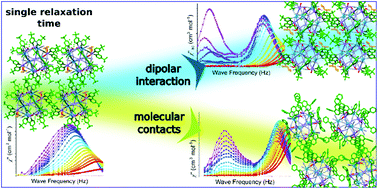Bulky ligands shape the separation between the large spin carriers to condition field-induced slow magnetic relaxation†
Abstract
Crystal engineering of magnetic relaxation in supramolecular networks based on almost isotropic cyanido-bridged {Mn9[W(CN)8]6L8(solv)8} clusters decorated by bulky 4,4′-di-tert-butyl-2,2′-bipyridine (But2bpy) and 4,7-diphenyl-1,10-phenanthroline (Ph2phen) ligands is presented. The three new compounds {MnII9[WV(CN)8]6(But2bpy)8(MeOH)8}·Pri2O·13MeOH (1), {MnII9[WV(CN)8]6(But2bpy)8(MeOH)6(H2O)2}·4Pri2O·2H2O (1a), and {MnII9[WV(CN)8]6(Ph2phen)8(MeOH)8}·29MeOH·6H2O (2) were characterized structurally and magnetically. Compound 1 exhibits unequivocal domination of repulsive intercluster contacts operating between the side But groups leading to intercluster distances exceeding 10 Å in all three dimensions. Compound 1a reveals a 1-dimensional (1D) supramolecular chain structure with very close intercluster distances of 6.7 Å realized through the direct W–CN⋯HO–Mn hydrogen bonds along the chain, further isolated by the above repulsive But⋯But synthons. Compound 2 shows significant separation in all three directions with the intercluster distances close to 10, 12 and 13.5 Å. However, in contrast to 1, these separations are accompanied by indirect hydrogen bond arrays and local π–π interactions of potential to assist in the transfer of weak magnetic interactions. The dc magnetic data show the signature of S = 39/2 in the ground state, which is typical in this group of compounds. The high-spin clusters are accompanied by different intercluster interactions, illustrated by the effective zJ′ values of +0.010 cm−1 (1), +0.008 cm−1 (1a) and +0.001 cm−1 (2). The low temperature ac susceptibility measurements revealed a temperature- and field-dependent magnetic relaxation time for all 1, 1a and 2 compounds (τ1, τ1a-fast, and τ2-fast in the range 10−3–10−4 s). In contrast and only in the case of 1a and 2, an additional temperature independent slow process was detected (τ1a-slow and τ2-slow located between 0.1 s and 1 s). The magnetic relaxations were correlated with the obtained supramolecular networks, indicating the significant role of dipolar fields, weak non-covalent interactions, hydrogen bonds and π–π interactions.



 Please wait while we load your content...
Please wait while we load your content...